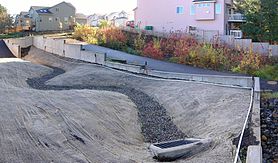- Check dam
-
 A common application of check dams is in bioswales, which are artificial drainage channels that are designed to remove silt and pollution from runoff.
A common application of check dams is in bioswales, which are artificial drainage channels that are designed to remove silt and pollution from runoff.
A check dam is a small dam, which can be either temporary or permanent, built across a minor channel, swale, bioswale, or drainage ditch. Similar to drop structures in purpose, they reduce erosion and gullying in the channel and allow sediments and pollutants to settle. They also lower the speed of water flow during storm events. Check dams can be built with logs, stone, or sandbags. Of these, the former two are usually permanent or semi-permanent; and the sandbag check dam is usually for temporary purposes. Also, there are check dams that are constructed with rockfill or wooden boards. These dams are usually used only in small, open channels that drain 10 acres (0.040 km2) or less; and usually do not exceed 2 feet (0.61 m) high.[1]
Many check dams tend to form stream pools. Under low-flow circumstances, water either infiltrates into the ground, evaporates, or seeps through or under the dam. Under high flow (flood) conditions, water flows over or through the structure. Coarse and medium-grained sediment from runoff tends to be deposited behind check dams, while finer grains are usually allowed through. Extra nutrients, phosphorus, nitrogen, heavy metals, and floating garbage are also trapped or eliminated by the presence of check dams, increasing their effectiveness as water quality control measures. In nearly all instances, erosion control blankets, which are biodegradable open-weave blankets, are used in conjunction with check dams. These blankets help enforce vegetation growth on the slopes, shorelines and ditch bottoms.[2]
See also
References
- ^ "Check Dam". ftp://ftp-fc.sc.egov.usda.gov/WSI/UrbanBMPs/water/erosion/checkdam.pdf. Retrieved 2009-03-12.
- ^ "Sediment Control: Check Dams". http://www.metrocouncil.org/environment/watershed/BMP/CH3_RPPSedCheckdam.pdf. Retrieved 2009-03-12.
Categories:- Environmental engineering
- Hydrology and urban planning
- Landscape
- Waste treatment technology
- Water pollution
- Dams by type
Wikimedia Foundation. 2010.
